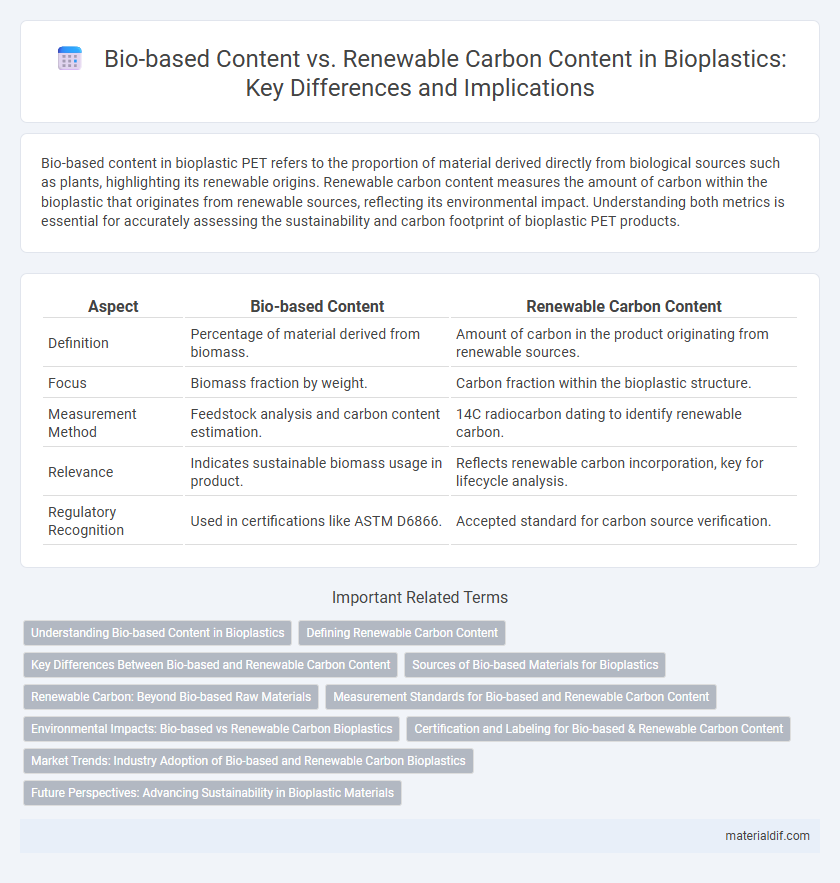Bio-based content in bioplastic PET refers to the proportion of material derived directly from biological sources such as plants, highlighting its renewable origins. Renewable carbon content measures the amount of carbon within the bioplastic that originates from renewable sources, reflecting its environmental impact. Understanding both metrics is essential for accurately assessing the sustainability and carbon footprint of bioplastic PET products.
Table of Comparison
| Aspect | Bio-based Content | Renewable Carbon Content |
|---|---|---|
| Definition | Percentage of material derived from biomass. | Amount of carbon in the product originating from renewable sources. |
| Focus | Biomass fraction by weight. | Carbon fraction within the bioplastic structure. |
| Measurement Method | Feedstock analysis and carbon content estimation. | 14C radiocarbon dating to identify renewable carbon. |
| Relevance | Indicates sustainable biomass usage in product. | Reflects renewable carbon incorporation, key for lifecycle analysis. |
| Regulatory Recognition | Used in certifications like ASTM D6866. | Accepted standard for carbon source verification. |
Understanding Bio-based Content in Bioplastics
Bio-based content in bioplastics refers to the proportion of materials derived from renewable biological sources, such as plant biomass, used in the polymer structure. It highlights the share of organic carbon originating directly from contemporary biological processes as opposed to fossil-based carbon, which is crucial for assessing environmental impact and sustainability. Understanding the bio-based content is essential for certification, labeling, and promoting the circular economy by reducing reliance on non-renewable resources.
Defining Renewable Carbon Content
Renewable Carbon Content measures the proportion of carbon in a bioplastic derived from renewable resources like plants, algae, or bio-waste, highlighting its contribution to reducing fossil carbon dependency. Unlike Bio-based Content, which quantifies the total non-fossil material, Renewable Carbon Content specifically tracks renewable carbon atoms incorporated into the polymer structure. This metric provides a clearer environmental impact assessment by focusing on carbon originating from renewable sources, essential for evaluating sustainability in bioplastic production.
Key Differences Between Bio-based and Renewable Carbon Content
Bio-based content measures the proportion of raw materials derived directly from biomass, such as plants or animal sources, in a bioplastic product. Renewable carbon content evaluates the amount of carbon within the material that originates from renewable resources, including biomass and recycled carbon from waste. The key difference lies in bio-based content emphasizing the source material's origin, while renewable carbon content focuses on the carbon atoms' renewable origin, impacting certification and sustainability assessments in bioplastic production.
Sources of Bio-based Materials for Bioplastics
Bio-based content in bioplastics refers to the proportion of material derived directly from biomass such as corn starch, sugarcane, or cellulose, whereas renewable carbon content measures the fraction of carbon in the plastic originating from renewable sources regardless of the material's origin. Sources of bio-based materials for bioplastics primarily include plants like sugarcane, corn, and cassava, as well as lignocellulosic biomass from agricultural residues and forestry byproducts. These sources contribute to the development of sustainable bioplastics with reduced reliance on fossil fuels and lower environmental impact.
Renewable Carbon: Beyond Bio-based Raw Materials
Renewable Carbon Content encompasses all carbon derived from renewable sources, including bio-based raw materials, recycled carbon, and carbon captured from the air. This broader metric offers a more comprehensive assessment of bioplastic sustainability by accounting for recycled and atmospheric carbon inputs beyond traditional biomass. Measuring renewable carbon content promotes the development of innovative feedstocks and circular carbon utilization strategies in bioplastic production.
Measurement Standards for Bio-based and Renewable Carbon Content
Measurement standards such as ASTM D6866 and ISO 16620-2 provide reliable methods for quantifying bio-based content and renewable carbon content in bioplastics by analyzing radiocarbon (C-14) levels. ASTM D6866 measures the fraction of bio-based carbon by comparing the C-14 isotope concentration to a modern reference, offering a percentage value of renewable origin carbon in the material. ISO 16620-2 complements this by defining terms, procedures, and units, ensuring consistent reporting and certification across industries for bioplastic sustainability claims.
Environmental Impacts: Bio-based vs Renewable Carbon Bioplastics
Bio-based content in bioplastics refers to the proportion of material derived from biomass, significantly reducing dependence on fossil fuels and lowering carbon footprints. Renewable carbon content encompasses all carbon sources that can be replenished naturally, including bio-based and recycled carbon, enhancing circularity and minimizing environmental impacts. Comparing bio-based and renewable carbon bioplastics highlights that while both aim to decrease greenhouse gas emissions, renewable carbon content broadens sustainability by integrating recycled materials, further reducing resource depletion and waste generation.
Certification and Labeling for Bio-based & Renewable Carbon Content
Certification for bio-based content typically involves standards such as ASTM D6866, which measures the proportion of renewable carbon in a product through radiocarbon analysis. Renewable carbon content certification encompasses not only bio-based materials but also recycled carbon sources, reflecting a broader carbon origin scope. Labels like the USDA Certified Biobased Product label and the TUV AUSTRIA OK biobased verify compliance with these standards, offering transparency and credibility to consumers regarding the renewable and bio-based composition of bioplastics.
Market Trends: Industry Adoption of Bio-based and Renewable Carbon Bioplastics
Market trends reveal a growing industry adoption of bio-based content bioplastics, driven by consumer demand for sustainable materials and stricter environmental regulations. Renewable carbon content bioplastics gain traction as companies seek to increase biomass-derived feedstocks in polymers, aligning with circular economy goals. Major players in packaging, automotive, and consumer goods sectors are investing in bio-based and renewable carbon bioplastic technologies to enhance sustainability profiles and reduce carbon footprints.
Future Perspectives: Advancing Sustainability in Bioplastic Materials
Bio-based content measures the percentage of biomass-derived carbon in bioplastics, while renewable carbon content encompasses all carbon from renewable sources, including biomass and recycled carbon. Future perspectives in bioplastic development emphasize enhancing renewable carbon content to improve material circularity and reduce dependency on fossil fuels. Innovations in feedstock diversification and advanced recycling technologies are driving the transition towards fully renewable and sustainable bioplastic materials.
Bio-based Content vs Renewable Carbon Content Infographic

 materialdif.com
materialdif.com